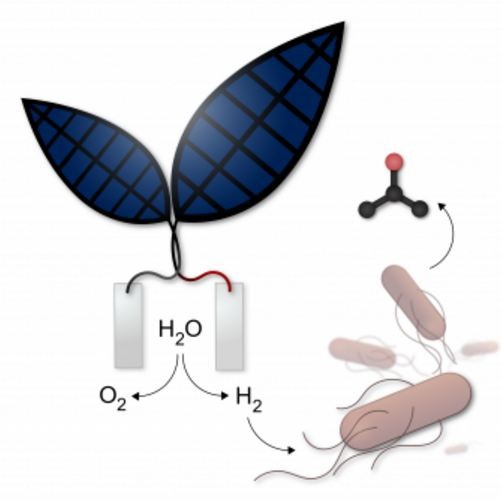Improved Bionic Leaf Converts Sunlight into Liquid Fuels such as Isopropanol
| Arthur Dominic Villasanta | | Jun 03, 2016 07:59 PM EDT |
(Photo : Jessica Polka/Silver Lab) How the bionic leaf works
Harvard scientists have unveiled an improved version of a "bionic leaf" that converts solar energy into liquid fuel through an artificial version of photosynthesis that's more efficient than the natural version.
"Bionic Leaf 2.0" uses solar electricity generated by solar panels to divide water molecules into oxygen and hydrogen, their component elements. The hydrogen is then transferred to a chamber where a bacteria called Ralstonia eutropha feed on it and converts CO2 in the air into alcohol fuels. The process uses a special cobalt and phosphorus catalyst to generate liquid fuel.
Like Us on Facebook
The new catalyst improved version 2.0's efficiency at producing alcohol fuels like isopropanol and isobutanol to about 10 percent. That also means for every kilowatt hour of electricity used, the microbes can remove 130 grams of CO2 out of 230,000 liters of air to make 60 grams of isopropanol fuel.
That's better than the efficiency of natural photosynthesis at converting water sunlight and air into stored energy.
The new artificial leaf has been able to operate for up to 16 days at a go, said chemist Daniel Nocera of Harvard. His team worked with synthetic biologist Pamela Silver of Harvard Medical School on the new version. Nocera described Bionic Leaf 2.0 as a melding of biology and technology.
"This is a true artificial photosynthesis system," said Nocera. "Before, people were using artificial photosynthesis for water-splitting, but this is a true A-to-Z system, and we've gone well over the efficiency of photosynthesis in nature."
The team's first artificial photosynthesis device appeared in 2015 but the team went back to the drawing board to seek out a better catalyst. Nocera said the new catalyst can never die while it's functioning.
He also noted the new cobalt catalyst also splits water into hydrogen and oxygen without generating reactive oxygen molecules that can damage DNA or other processes essential to continuing life.
Tagsbionic leaf, Bionic Leaf 2.0, Photosynthesis, Ralstonia eutropha, Harvard, Daniel Nocera, Pamela Silver
©2015 Chinatopix All rights reserved. Do not reproduce without permission
EDITOR'S PICKS
-

Did the Trump administration just announce plans for a trade war with ‘hostile’ China and Russia?
-

US Senate passes Taiwan travel bill slammed by China
-

As Yan Sihong’s family grieves, here are other Chinese students who went missing abroad. Some have never been found
-

Beijing blasts Western critics who ‘smear China’ with the term sharp power
-

China Envoy Seeks to Defuse Tensions With U.S. as a Trade War Brews
-

Singapore's Deputy PM Provides Bitcoin Vote of Confidence Amid China's Blanket Bans
-

China warns investors over risks in overseas virtual currency trading
-

Chinese government most trustworthy: survey
-

Kashima Antlers On Course For Back-To-Back Titles
MOST POPULAR
LATEST NEWS
Zhou Yongkang: China's Former Security Chief Sentenced to Life in Prison

China's former Chief of the Ministry of Public Security, Zhou Yongkang, has been given a life sentence after he was found guilty of abusing his office, bribery and deliberately ... Full Article
TRENDING STORY

China Pork Prices Expected to Stabilize As The Supplies Recover

Elephone P9000 Smartphone is now on Sale on Amazon India

There's a Big Chance Cliffhangers Won't Still Be Resolved When Grey's Anatomy Season 13 Returns

Supreme Court Ruled on Samsung vs Apple Dispute for Patent Infringement

Microsoft Surface Pro 5 Rumors and Release Date: What is the Latest?













